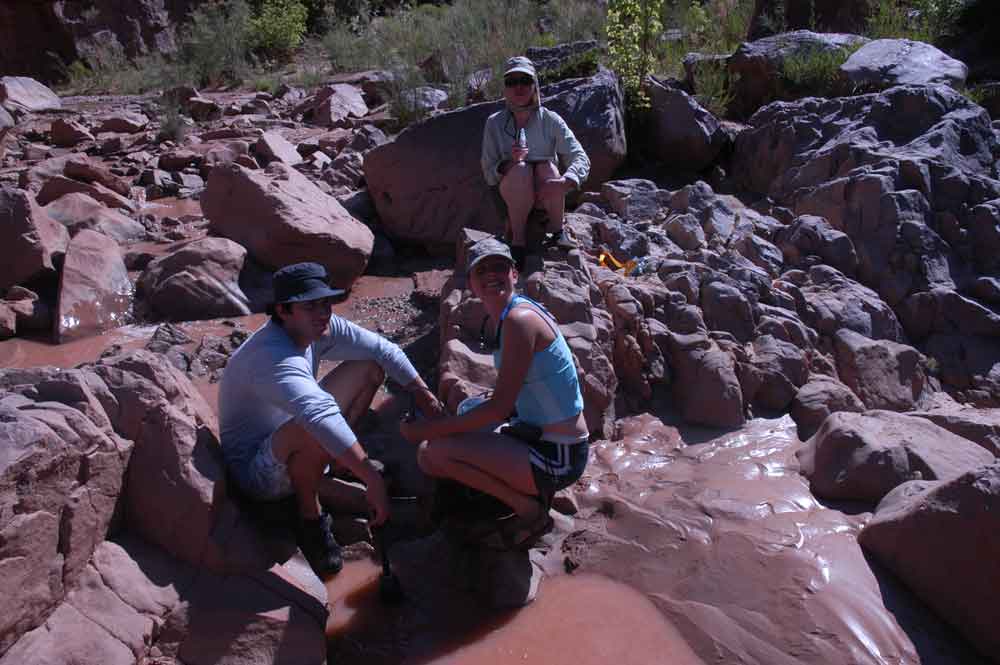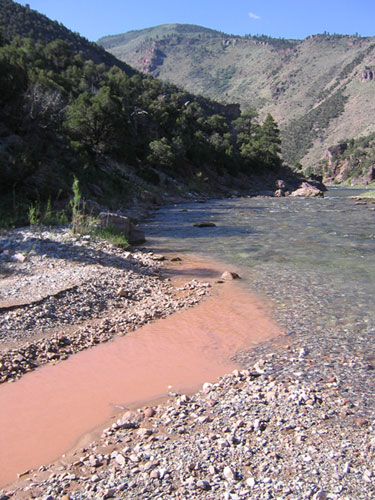Geomorphic Description

The confluence between Red Creek and the Green River is located on river left near the bottom of Red Canyon. Draining approximately 140 square miles of the northeastern Uinta Mountains, Red Creek is the first major sediment source for the sediment starved Green River downstream from Flaming Gorge Dam. Historic debris flows deposited cobble and boulder-sized sediment at the mouth of Red Creek, constricting the Green River against the bedrock canyon wall on river right, creating both a large upstream pool and substantial rapid at the constriction locality. Unable to transport these large sediments, subsequent debris flows have deposited cobble and gravel-sized materials both upstream and downstream from the original debris fan. Active channels dissect these debris- fan surfaces, ephemerally transporting silt, sand and gravel-sized sediments to the Green River. The main channel draining Red Creek flows in a southerly direction, meeting the Green River approximately 350 meters downstream from the channel constriction. Due to the lack of upstream sediment sources, active floodplain surfaces are well armored and mostly devoid of the fine to medium- sized sediments supplied by Red Creek. Site vegetation is dominated by tamarisk which has invaded both the active floodplain, intermediate bench and pre-dam geomorphic surfaces.


Riparian Vegetation
The sampling transect ran perpendicular to the river in the approximate center of the debris-fan and intersected the post-dam terrace, intermediate bench and pre-dam terrace (see geomorphology map).Tamarisk recruits were observed in very high numbers upstream of the transect location. The transect attempted to capture the most diversity. On the transect, coyote willow and tamarisk recruits were seen as a mixed population in the post-dam terrace regions (Fig. 1). These post-dam surfaces are not found solely bordering the Green River because Red Creek has eroded channels throughout the fan, creating several suitable areas for post-dam terrace vegetation (see geomorphology cross-section). The pre-dam terrace was observed once the transect crossed the active channel side channel. This terrace backed into the bedrock and employed the most diversity of species assemblage on this transect, including coyote willow, rabbitbrush, cottonwood and tamarisk (Fig. 1). Cottonwoods sampled were small recruits, but a few mature cottonwood were present outside of the sampled area. Cottonwoods may possibly find the natural hydrograph of Red Creek beneficial.

Most of the debris-fan, however, was not accurately represented by our transect. On the upstream edge of the debris-fan created by Red Creek, coyote willow was observed in dense populations. Many of the willow appeared to be of one or two age classes, suggesting only a few recruitment events. We also noticed the back channel to be a strongly mixed population of coyote willow and tamarisk. Yet, on the downstream portion of the fan bordering the Green River no tamarisk was observed, only dense populations of coyote willow and several cottonwood recruits. Marsh vegetation was also observed on the cut-bank region of this downstream area.
Water Quality

In this picture, it is clear that Red Creek (left) is highly turbid compared to the Green River. Red Creek has an extremely small discharge relative to the Green River, and thus its impact on turbidity is only seen locally (within approximately 20m downstream) and has no substantial effect on the river. It should also be noted that a large precipitation event had occurred recently in the Red Creek watershed according to a local park ranger.

Fish
Seine Collection Data:


General Comments: Many large adult brown and rainbow trout were observed and caught fly-fishing in the stretch of river from Flaming Gorge Dam to Red Creek. In addition, a mottled sculpin was caught with a dip net a short distance from the dam. We were unable to positively identify the juvenile salmonids to species. Seining occurred during daylight hours.
Aquatic Invertebrates


Sampling sites were selected for similar flows above and below the confluence of Red Creek with the Green River. Substrate size and aquatic vegetation cover were estimated.


Birds, Mammals, Reptiles, and Amphibians
We surveyed this site for an hour in mid-morning during a slight breeze and less than 25% cloud cover. This site encompasses the confluence of Red Creek with the Green River. The habitat consists primarily of pinyon-juniper woodlands and surrounding canyon ledges. Birds were identified by visual sightings or song recognition. Reptiles were identified by visual sightings, hand capture, or fishing pole noose capture. Mammals were identified by visual sightings or track recognition. The Red Creek survey site contained a plethora of habitats for a variety of animal species. The water from Red Creek provided a long stretch of mud that made it easy to identify mammal species by their tracks. We found lizards in the rocky regions of the canyon slope whereas we found snakes in the grasses on the bank. We caught one racer as he moved through the grasses (Fig. 1). On the banks of Red Creek we discovered a deer's leg protruding from a mound of soil (Fig. 2). We also found a deer fawn at the base of a dead juniper tree in a flat area directly before the slope of a hill (Fig. 3). The constriction of the Green River at this site provided swiftly flowing water necessary for the American dipper. The canyon ledges in this site provide suitable habitat for the canyon wrens.




